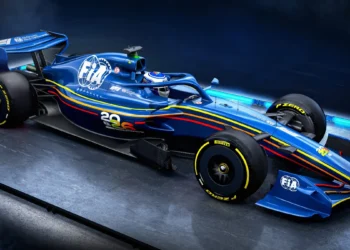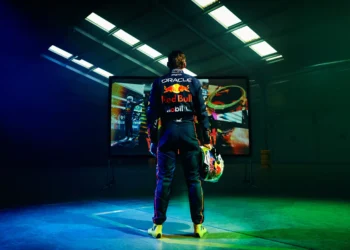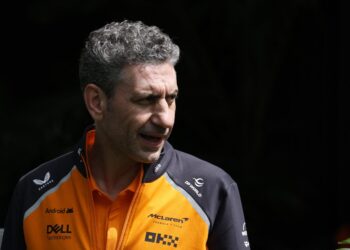In a scathing critique of the current safety measures in the World Rally Championship (WRC), eight-time champion Sébastien Ogier has called for a complete rethink of the controversial virtual chicanes introduced to slow down cars on high-speed stages. Ogier’s criticism comes after his firsthand experience with the system during the recent Secto Rally Finland, where he argued that the GPS-based technology is far from reliable and poses significant safety risks.
Virtual Chicanes: A Flawed System in High-Speed Rallying?
The concept of virtual chicanes was introduced to the WRC as a method to reduce the average speeds on some of the championship’s most dangerous stages. Unlike traditional chicanes, which involve physical obstacles that drivers must navigate, virtual chicanes require drivers to decelerate to a designated speed within a specific zone, monitored by a GPS system. The goal is to maintain the challenge of the course while reducing the risk of high-speed accidents.
However, Ogier, a veteran of the sport with more than a decade of experience, has raised serious concerns about the effectiveness and safety of this system. “The chicane is not accurate, it’s not accurate at all,” Ogier declared, criticizing the GPS-based monitoring as unreliable. He pointed out that drivers are forced to divert their attention from the road to check their speed on the dashboard, a distraction that could lead to dangerous situations in the already perilous conditions of rally racing.
The Debate Over Accuracy: GPS vs. Radar
Ogier’s main contention with the virtual chicanes is the use of GPS to measure vehicle speed. He argues that the inherent inaccuracies of GPS technology make it an unreliable tool for such a critical task. “You brake, you brake, and you just wait that this stupid signal is activating the things,” Ogier lamented, describing the frustrating experience of trying to comply with the chicane requirements.
In contrast, Ogier advocates for a system used in Finnish national rallies, where radar guns, similar to those used by police, are employed to measure the speed of vehicles. This method, according to Ogier, offers a higher degree of accuracy and consistency. Finnish events like Itäralli have successfully implemented radar-based virtual chicanes, where an official operates the radar, and a visible signboard displays the vehicle’s speed to the driver, ensuring clarity and precision.
Henrik Frank, AKK’s sporting executive for rally, supports Ogier’s stance, noting that the radar-based system has worked well in Finnish national events. “We have used virtual chicanes only on two occasions in Finnish national events, and in both of those there have been radar (operated by an official) and a screen, which shows the actual speed for competitors,” Frank explained. This method, he believes, is more “competitor friendly” and provides a more accurate measure of compliance.
The Diverging Views on Safety and Implementation
Despite Ogier’s strong criticism, the FIA has defended its choice of the GPS-based system, citing its ability to monitor vehicle speed in real-time and enforce speed limits instantly. Xavier Mestelan-Pinon, FIA’s chief technical and safety officer, acknowledged the challenges but emphasized that the GPS system offers comprehensive enforcement across a designated zone, something that radar systems cannot provide. “While speed guns are accurate, they require human intervention and the result must be in some way notified to the car, which is practically more complex to implement,” Mestelan-Pinon said.
The FIA has also considered alternative systems, such as the “happy face/sad face” speed notification, but found them less effective than GPS monitoring. The organization remains open to exploring improvements but maintains that the current system is the most practical solution for the time being.
Driver Feedback and the Future of Virtual Chicanes
Sébastien Ogier is not alone in his dissatisfaction with the current virtual chicane system. WRC2 contender Lauri Joona, who has extensive experience with virtual chicanes in various rallies, including Finland’s Itäralli and Rally Roma di Capitale in the ERC, echoed Ogier’s concerns. Joona pointed out that while virtual chicanes can be acceptable where physical chicanes are not feasible, the current system’s accuracy leaves much to be desired. “The system should be a bit more accurate,” Joona remarked, stressing that the intention behind virtual chicanes is to ensure uniformity in speed reduction, which is currently compromised by the GPS inaccuracies.
Both Ogier and Joona’s feedback suggests a growing consensus among drivers that while the concept of virtual chicanes has merit, the implementation needs significant refinement. The reliance on GPS technology, while convenient, may not be sufficient for the high-stakes world of rally racing, where precision and safety are paramount.
Will WRC Listen to Its Drivers?
As the WRC continues to evolve, the debate over virtual chicanes highlights a broader issue of balancing safety with competition. Sébastien Ogier’s call for a shift to radar-based systems, which have proven effective in national rallies, raises important questions about the future of these safety measures in the world’s most demanding rally series.
For now, the FIA stands by its GPS-based system, but with top drivers like Ogier pushing for change, the pressure to reconsider could lead to significant adjustments in the near future. Whether the organization will heed these calls remains to be seen, but one thing is certain: the safety and integrity of the sport depend on getting these decisions right.
Photo from Sébastien Ogier Instagram










